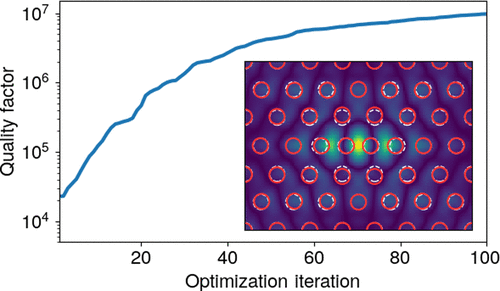当前位置:
X-MOL 学术
›
ACS Photonics
›
论文详情
Our official English website, www.x-mol.net, welcomes your feedback! (Note: you will need to create a separate account there.)
Inverse Design of Photonic Crystals through Automatic Differentiation
ACS Photonics ( IF 7 ) Pub Date : 2020-06-09 , DOI: 10.1021/acsphotonics.0c00327 Momchil Minkov 1 , Ian A. D. Williamson 1 , Lucio C. Andreani 2 , Dario Gerace 2 , Beicheng Lou 3 , Alex Y. Song 1 , Tyler W. Hughes 3 , Shanhui Fan 1
ACS Photonics ( IF 7 ) Pub Date : 2020-06-09 , DOI: 10.1021/acsphotonics.0c00327 Momchil Minkov 1 , Ian A. D. Williamson 1 , Lucio C. Andreani 2 , Dario Gerace 2 , Beicheng Lou 3 , Alex Y. Song 1 , Tyler W. Hughes 3 , Shanhui Fan 1
Affiliation

|
Gradient-based inverse design in photonics has already achieved remarkable results in designing small-footprint, high-performance optical devices. The adjoint variable method, which allows for the efficient computation of gradients, has played a major role in this success. However, gradient-based optimization has not yet been applied to the mode-expansion methods that are the most common approaches to studying periodic optical structures such as photonic crystals. This is because, in such simulations, the adjoint variable method cannot be defined as explicitly as in standard finite-difference or finite-element time- or frequency-domain methods. Here, we overcome this gap through the use of automatic differentiation, which is a generalization of the adjoint variable method to arbitrary computational graphs. We implement the plane-wave expansion and the guided-mode expansion methods using an automatic differentiation library, and we show that the gradient of any simulation output can be computed efficiently and in parallel, with respect to all input parameters. We then use this implementation to optimize the dispersion of a photonic crystal waveguide, and the quality factor of an ultrasmall cavity in a lithium niobate slab. This extends photonic inverse design to an entirely new class of simulations, and more broadly highlights the importance that automatic differentiation could play in the future for tracking and optimizing complicated physical models.
中文翻译:

通过自动微分进行光子晶体逆设计
光子学中基于梯度的逆设计在设计小尺寸,高性能光学器件方面已经取得了显著成果。伴随变量方法可以有效地计算梯度,在此成功中发挥了重要作用。但是,基于梯度的优化尚未应用于模式扩展方法,该方法是研究周期性光学结构(如光子晶体)的最常用方法。这是因为,在这种模拟中,不能像标准有限差分法或时域或频域有限元法那样明确定义伴随变量法。在这里,我们通过使用自动微分来克服此差距,这是伴随变量方法对任意计算图的推广。我们使用自动微分库实现了平面波扩展和导模扩展方法,并且我们展示了可以相对于所有输入参数高效且并行地计算任何模拟输出的梯度。然后,我们使用此实现来优化光子晶体波导的色散以及铌酸锂平板中超小腔的品质因数。这将光子逆设计扩展到了全新的仿真类别,并且更广泛地强调了自动微分在将来对于跟踪和优化复杂物理模型的重要性。关于所有输入参数。然后,我们使用此实现来优化光子晶体波导的色散以及铌酸锂平板中超小腔的品质因数。这将光子逆设计扩展到了全新的仿真类别,并且更广泛地强调了自动微分在将来对于跟踪和优化复杂物理模型的重要性。关于所有输入参数。然后,我们使用此实现来优化光子晶体波导的色散和铌酸锂平板中超小腔的品质因数。这将光子逆设计扩展到了全新的仿真类别,并且更广泛地强调了自动微分在将来对于跟踪和优化复杂物理模型的重要性。
更新日期:2020-07-15
中文翻译:

通过自动微分进行光子晶体逆设计
光子学中基于梯度的逆设计在设计小尺寸,高性能光学器件方面已经取得了显著成果。伴随变量方法可以有效地计算梯度,在此成功中发挥了重要作用。但是,基于梯度的优化尚未应用于模式扩展方法,该方法是研究周期性光学结构(如光子晶体)的最常用方法。这是因为,在这种模拟中,不能像标准有限差分法或时域或频域有限元法那样明确定义伴随变量法。在这里,我们通过使用自动微分来克服此差距,这是伴随变量方法对任意计算图的推广。我们使用自动微分库实现了平面波扩展和导模扩展方法,并且我们展示了可以相对于所有输入参数高效且并行地计算任何模拟输出的梯度。然后,我们使用此实现来优化光子晶体波导的色散以及铌酸锂平板中超小腔的品质因数。这将光子逆设计扩展到了全新的仿真类别,并且更广泛地强调了自动微分在将来对于跟踪和优化复杂物理模型的重要性。关于所有输入参数。然后,我们使用此实现来优化光子晶体波导的色散以及铌酸锂平板中超小腔的品质因数。这将光子逆设计扩展到了全新的仿真类别,并且更广泛地强调了自动微分在将来对于跟踪和优化复杂物理模型的重要性。关于所有输入参数。然后,我们使用此实现来优化光子晶体波导的色散和铌酸锂平板中超小腔的品质因数。这将光子逆设计扩展到了全新的仿真类别,并且更广泛地强调了自动微分在将来对于跟踪和优化复杂物理模型的重要性。



























 京公网安备 11010802027423号
京公网安备 11010802027423号